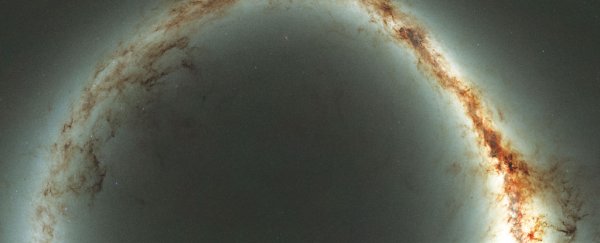Scientists have made the largest ever survey of the night sky publicly available, sharing an epic data set of astronomical objects that took four years to put together.
The Pan-STARRS project represents about half a million composite snapshots of the night sky as seen from Hawaii, and now researchers have begun making the whole resource free to download for anyone who wants to explore space from the comfort of home.
"The Pan-STARRS1 Surveys allow anyone to access millions of images and use the database and catalogues containing precision measurements of billions of stars and galaxies," said director of the Pan-STARRS Observatories, Ken Chambers.
"With this release we anticipate that scientists – as well as students and even casual users – around the world will make many new discoveries about the Universe from the wealth of data collected by Pan-STARRS."
 Compressed view of the entire sky visible from Hawaii by the Pan-STARRS1 Observatory. The shape comes from making a map of the celestial sphere, like a map of Earth, but leaving out the southern quarter. The disk of the Milky Way looks like a yellow arc, and the dust lanes show up as reddish brown filaments. Credit: Danny Farrow, Pan-STARRS1 Science Consortium and Max Planck Institute for Extraterrestrial Physics
Compressed view of the entire sky visible from Hawaii by the Pan-STARRS1 Observatory. The shape comes from making a map of the celestial sphere, like a map of Earth, but leaving out the southern quarter. The disk of the Milky Way looks like a yellow arc, and the dust lanes show up as reddish brown filaments. Credit: Danny Farrow, Pan-STARRS1 Science Consortium and Max Planck Institute for Extraterrestrial Physics
The Pan-STARRS (Panoramic Survey Telescope and Rapid Response System) began operations in May 2010, using a 1.8-metre telescope called Pan-STARRS1 or PS1.
Located at the summit of Haleakalā, on Maui, Hawaii, Pan-STARRS1 records images of the night sky in visible and near infrared light.
And those images are extremely detailed, given the telescope is equipped with a 1.4-gigapixel digital camera – the most powerful digital camera ever built (for now) – meaning it records about 1.4 billion pixels per image.
With that resolution, each image captures a patch of sky about 36 times the area of the Moon as seen from Earth. With new shots taken every 30 seconds for four years, and each image measuring a hefty 2 gigabytes or so, the overall collection adds up to an insane 2 petabytes (2,000 terabytes, or 2 million gigabytes).
As the scientists explain, that's equivalent to around 1 billion selfies, or 100 times the total content of Wikipedia.
But aside from the almost ridiculous digital size of the data set, even more amazing is the abundance of astronomical phenomena it contains. The visual record is made of 3 billion separate image sources, comprising both near and distant stars and galaxies, plus space objects much closer to home.
"Pan-STARRS has made discoveries from Near Earth Objects and Kuiper Belt Objects in the Solar System to lonely planets between the stars," says Chambers.
"[It] has mapped the dust in three dimensions in our galaxy and found new streams of stars; and it has found new kinds of exploding stars and distant quasars in the early Universe."
 The Pan-STARRS1 Observatory on Halealakala, Maui. Credit: Rob Ratkowski
The Pan-STARRS1 Observatory on Halealakala, Maui. Credit: Rob Ratkowski
The Pan-STARRS program was the work of 10 research institutions in four countries, assisted by NASA and the US National Science Foundation (NSF).
But while the astronomers working on the project may have already discovered a lot thus far, they know the data set will be even more productive and valuable once it's unleashed upon the rest of the world.
"[The] discoveries that come after this release, there'll be more of them than the things we've been doing over the past four to five years, and that's part of the point," says Chambers.
"This is a resource, it's a bonanza of data to be released. Scientists and people going through [it] will be able to find a wealth of new things that we can't even imagine – that's why we're putting it out there."
The Pan-STARRS rollout is occurring in two phases. This week's release is called "Static Sky", showing the average values for each astronomical object, in terms of its position in the sky, brightness, and colours.
A second release of data, to be made available next year, will reveal the cosmic phenomena as seen throughout various astronomical epochs.
Taken together, the 2-petabyte data set in total would take up some 40 million four-drawer filing cabinets if it were printed out on paper with single-spaced texts, so it's just as well you can search and download from the archive at your leisure.
You can find out more about the project in the video below:
